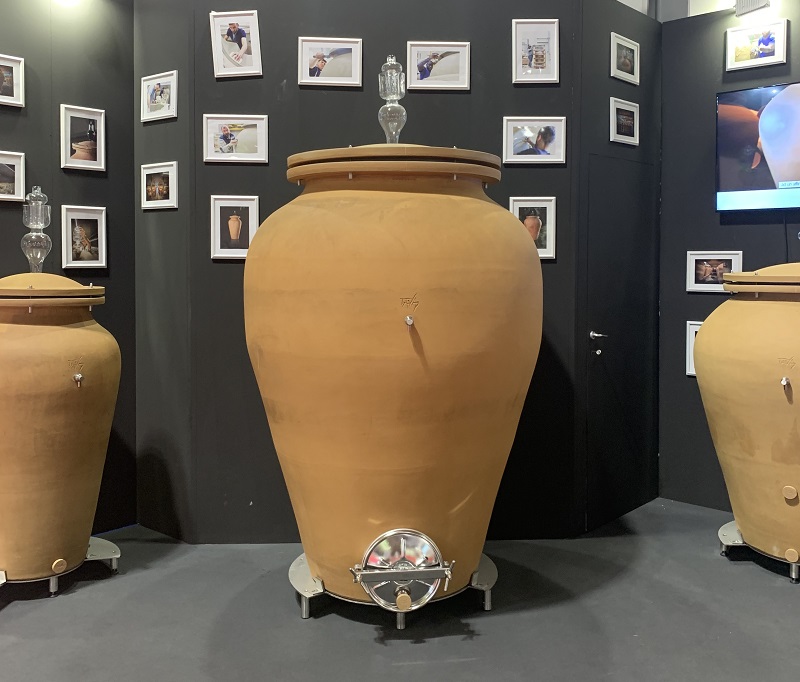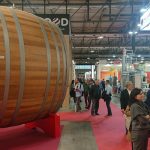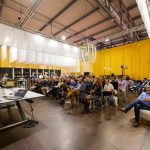Regular writer Sam Bowman recently travelled to Milan, Italy, to attend SIMEI — the International Enological and Bottling Equipment Exhibition — and its companion event Enovitis Business vineyard technology exhibition on behalf of Grapegrower & Winemaker and has compiled the following report on the equipment and technology that most caught his attention.
The Salone Internazionale and Macchine per Enologia e Imbottigliamento (SIMEI), or International Enological and Bottling Equipment Exhibition was held in Milan, Italy, over three winter days in late November 2019. I was lucky enough to be sent along on behalf of the Australian & New Zealand Grapegrower & Winemaker magazine.
The exhibition draw together leaders in wine and beverage technology from all over the world, displaying the latest in technological innovations for our wine and viticulture sectors. In 2019, 560 exhibitors from multiple countries were on show giving attendees a glimpse into the future of our wine world and the general direction many companies are moving towards.
Held in tandem with SIMEI was Enovitis Business — a vineyard technology exhibition. Whilst the viticulture sector wasn’t as well represented as the wine production space, there were some gems for the vineyard dorks such as myself.
I report on the innovations that particularly caught my eye at both exhibitions.
Viticulture
Steel posts are continuing to make an impact abroad (and at home) and were well represented in various shapes, sizes and treatments to ensure weather and salt tolerance. Querying the price difference between timber and steel posts in Italy with Carmo, which produces both wood and steel products, its representative explained that wooden posts were only one euro cheaper than the steel options and for this reason, a majority of new vineyard plantings were 100% steel with growers opting away from wood.
In Australia many new vineyards are still going in with CCA and creosote posts despite the large stockpiles residing in our vineyard regions, something we will one day require a sustainable solution for their management.
The highlight (and talk of the conference between delegates) was the Bakus VitiBot. The VitiBot is a completely autonomous electric vineyard vehicle that is capable of mechanical weeding, midrow slashing, canopy trimming and recirculating spraying all in one operation.
The lithium batteries are capable of 10 hours run time (day and night) and require only 2.5 hours for a full charge making it an interesting prospect for Australian vineyards.
The unit is in operation across Italy and France with trials expected to commence in South Africa and Australia next year. The purchase cost in Europe is 200,000 Euro (for the unit as described above). If you add up the cost of a 90hp tractor at around $100,000, recirculating sprayer at $80,000, a mechanical weeder at $20,000 and a vine trimmer at $40,000, you reach $240,000 for plant alone without a full time operator, fungicide, herbicide or diesel use.
So, the VitiBot is not a completely ridiculous prospect for some vineyards. The unit runs off GPS guidance and utilises artificial intelligence for decision making which I was told improves as the bot spends more time in each vineyard. And, it also offers advantages from a health and safety perspective by avoiding the need to expose staff to agrochemicals or herbicides. This will be a very interesting one to watch.
Wine production
SIMEI is predominantly focussed on wine and beverage production and had a large presence from the major manufacturers, such as Della Toffola and Vaslin Bucher and a myriad of smaller producers, covering everything from lab testing to closures, packaging and bottling lines.
Talking with oak and maturation suppliers, there has been a resurgence in Europe (and somewhat in Australia) in the demand for large format oak and amphorae for small to medium producers. Tava is a third-generation Italian amphorae producer that has evolved with the current demands for sanitation and accessibility along with the desired characteristics gained from fermentation in concrete or ceramics.
Traditional amphorae now exhibit ground access for red fermentation, modern seals, tasting valves and air pressure relief on the lid for gas release when finishing fermentation. With many small Australian producers moving towards skin contact wines and minimal intervention I think we will be seeing more of this type of fermentation vessel going forward.
For larger wineries, the focus in Europe seems to be thermovinification. The process involves heating must from 25°C to between 70-85°C in around 30 seconds where it is held anywhere from two to 60 minutes (depending on the desired colour and tannin extraction). It is then flash cooled. The process allows red must to go directly to press and completely avoid maceration on skins which is a phenomenal advancement in winery process.
The ‘Red Hunter’ thermovinification plant, produced by TMCI Padovan (which was nominated for an innovation award), is capable of processing 60t/hr and claims to achieve similar colour and tannin extraction in one hour than in 10 days of traditional maceration on skins. For mid to large wineries this could avoid the inevitable bottleneck most regions are now experiencing when all red varieties mature at the same time and red fermentation space becomes the limiting factor on throughput.
I tasted some wines using the process ranging from zero to three days maceration after thermovinification and it was difficult to see a difference in mouthfeel which is promising. After returning home and discussing the process with some large wineries, it looks like this will be commonplace in many Australian operations in the future which is a great way to improve process and reduce the amount of loss in vineyards from delayed picking due to space limitations.
The highlight of SIMEI is the innovation awards which showcase advancements in technology, practices and products across all wine and beverage production fields. In 2019 the winner of the award was the e-WAK, produced by Guala Closures, which is an intelligent closure fitted with a microchip that can be read with a smartphone to produce a certificate of authenticity and product information. This is a brilliant way to not only build brand loyalty with consumers but also to combat wine fraud in icon Australian wines in international markets.
Conclusion
Attending international events such as SIMEI and Enovitis Business gives you a great appreciation of just how advanced we are in Australia and the brilliant people we have working in our industry, driving innovation every day. Whether or not all our tractor operators are soon to be replaced with robots, there is a sense that we are adapting to our current conditions both economically and in response to climate change with improved efficiency, more energy efficient processes and less chemical use and intervention.
With an uncertainty in the climate and the outlook on water security, it is comforting to know that human ingenuity is still striving to make the place we live better in some small way, even if it’s just what and how we drink.





















